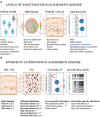Epigenetic Alterations in Alzheimer's Disease
- PMID: 26734709
- PMCID: PMC4681781
- DOI: 10.3389/fnbeh.2015.00347
Epigenetic Alterations in Alzheimer's Disease
Abstract
Alzheimer's disease (AD) is the major cause of dementia in Western societies. It progresses asymptomatically during decades before being belatedly diagnosed when therapeutic strategies have become unviable. Although several genetic alterations have been associated with AD, the vast majority of AD cases do not show strong genetic underpinnings and are thus considered a consequence of non-genetic factors. Epigenetic mechanisms allow for the integration of long-lasting non-genetic inputs on specific genetic backgrounds, and recently, a growing number of epigenetic alterations in AD have been described. For instance, an accumulation of dysregulated epigenetic mechanisms in aging, the predominant risk factor of AD, might facilitate the onset of the disease. Likewise, mutations in several enzymes of the epigenetic machinery have been associated with neurodegenerative processes that are altered in AD such as impaired learning and memory formation. Genome-wide and locus-specific epigenetic alterations have also been reported, and several epigenetically dysregulated genes validated by independent groups. From these studies, a picture emerges of AD as being associated with DNA hypermethylation and histone deacetylation, suggesting a general repressed chromatin state and epigenetically reduced plasticity in AD. Here we review these recent findings and discuss several technical and methodological considerations that are imperative for their correct interpretation. We also pay particular focus on potential implementations and theoretical frameworks that we expect will help to better direct future studies aimed to unravel the epigenetic participation in AD.
Keywords: Alzheimer’s disease; DNA methylation; epigenetics; histone acetylation; histone methylation; histone phosphorylation; neuroepigenetics.
Figures

References
Publication types
LinkOut - more resources
Full Text Sources
Other Literature Sources

